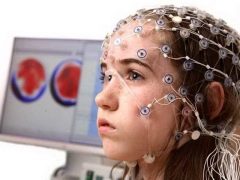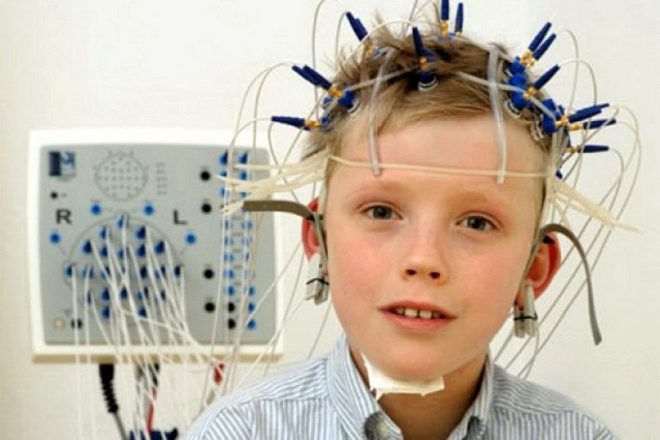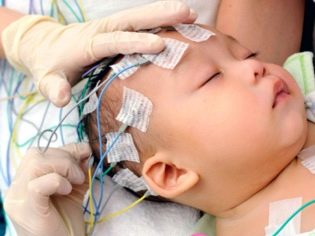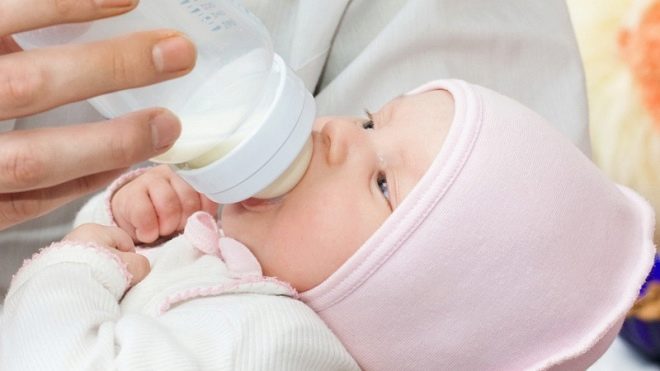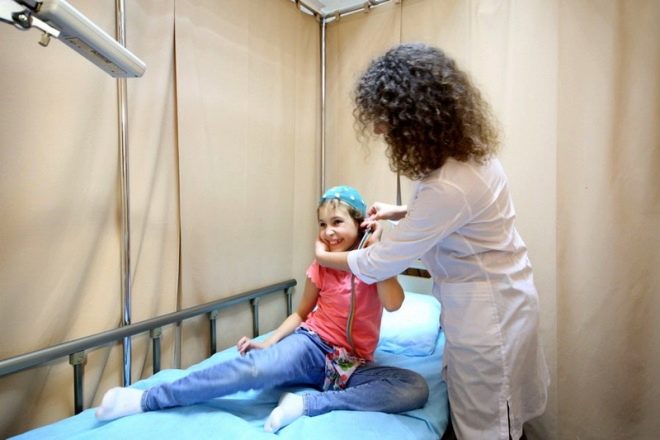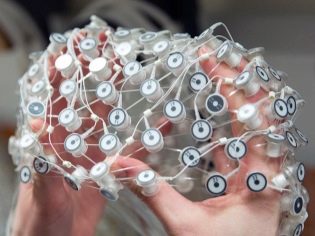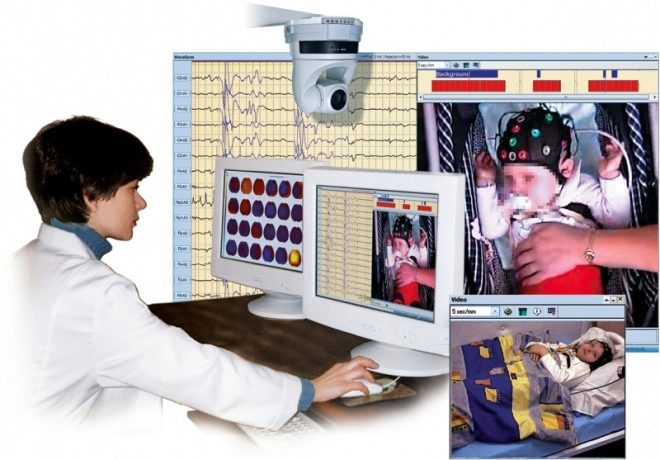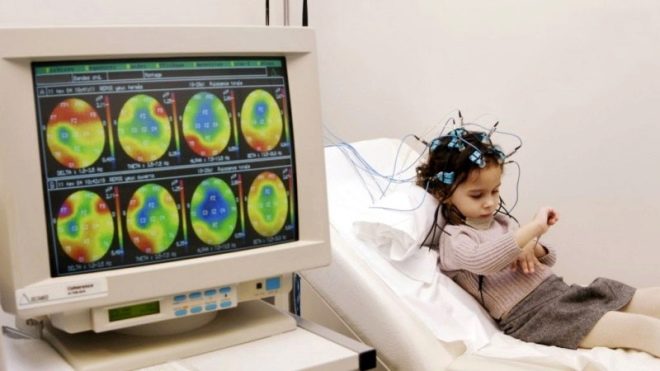What is brain encephalogram and why is it made to children?
There are many methods of examining the brain in children. Among them, EEG - electric encephalogram is given a worthy place. The method has a rather high accuracy. In this article we will explain why an encephalogram is made to children and what are the features of this procedure.
What it is?
This diagnostic method is based on fixing the electrical active impulses of the brain in a fixed period of time. This diagnostic method aims to establish the functionality of the brain. If a neoplasm or cyst is more helpful in diagnosing brain ultrasound, MRI or CT, then the task of electroencephalographic examination is different - to understand how the brain works, whether all its divisions are in order, whether there is necessary consistency between them, how the child reacts to different external stimuli .
To register the thinnest electrical impulses that the cerebral cortex produces, a special complex device is used - the encephalograph. It communicates with a helmet or cap on the head of a small patient through thin electrodes. Impulses on them from the child’s head come to the device and are recorded in the form of graphs on a paper tape or computer program.
The survey does not cause discomfort, pain. The method allows you to set the degree of brain damage in part of the loss of its normal functioning after injury, as a result of hypoxia and mental illness. In childhood, nocturnal childhood monitoring of brain electrical activity is widespread.
Why is it held?
Unlike neurosonography at the age of 1 month, EEG is not a mandatory examination. The procedure is recommended for the child if the doctor has any reason to assume that the patient has a violation of brain activity. Parents can be assigned to the diagnostic procedure in the following situations:
- the child often has a headache, episodes of dizziness occur;
- the baby lost consciousness for no apparent reason;
- the child had more than one episode of convulsions;
- there was a fall, a bruise, a header;
- the child is suspected to have cerebral palsy or the doctor needs to see the effect of the treatment on various forms of paralysis;
- the baby has reflexes;
- the child has difficulty falling asleep or, on the contrary, too much and is sleeping for a long time;
- have a baby suspected mental illness;
- the child is shown a full examination before brain surgery;
- the child has a pronounced delay in the development of speech, psyche and emotional sphere.
For infants who still have no complaints, electroencephalography is recommended in case of sleep disorders, unexplained frequent and prolonged or monotonous crying, copious regurgitation. To begin with, neurosonography is usually done, and if it does not show structural abnormalities, an EEG is performed.
Contraindications
There are no specific contraindications for the electroencephalogram of the brain. Diagnostics can be used for children of absolutely all age categories. But temporarily, the procedure will have to be abandoned if there are burns, wounds, postoperative fresh stitches on the child’s head.
It is also not recommended to make an encephalogram when there is a bad headache, in which nasal breathing is difficult or impossible, and also when there is a strong and frequent cough, since the activity of some brain centers will resemble the pathological cough, and when the head cold will experience a slight oxygen starvation.
For babies, it is undesirable to carry out an EEG in the waking state, as they may worry and cry, which will naturally affect the electrical impulse activity of the cerebral cortex. But this is not a contraindication in the full sense of the word, but a recommendation.
Harm from the survey - the truth and myths
On whether the survey is harmful, there are heated debates on thematic forums on the Internet. Parents fear electromagnetic radiation. The disturbances are completely groundless - the device does not affect the child with any radiation, it only acts as a receiver that picks up and captures the electrical impulses of the brain. Thus, the EEG procedure is considered to be completely safe, without any restrictions. Even if the child is small, even if he is recommended to do an EEG several times, no harm from the diagnosis will not be.
However, sometimes for young children have to use certain sedatives that will help the baby calm down and fall asleep before the diagnosis. Here they can be harmful, but only if the doctor incorrectly calculates the dosage or gives the child a certain drug without taking into account the individual intolerance of its components. But in practice this usually does not happen.
Do I need training?
Before passing the examination on the electroencephalograph, check the cleanliness of the child's hair, they must be clean, the scalp should not be greasy or contaminated. If you have a baby, then try to stand for a crumb for quite a long period without sleep, and 15 minutes before the examination, feed the child tightly. So the chances that he will sleep peacefully and soundly will be higher. It is better to feed already in a medical institutionso take a bottle of milk formula or expressed breast milk with you.
If the child is already over one and a half years old, he should be prepared psychologically for the upcoming procedure. Tell us about what awaits him and be sure to explain that the child will need to obey the doctor and carry out his commands. That is why it is better to present EEG in the form of a fun game. Rehearse at home - put a hat on the child's head and ask him to blink, strongly breathe deeply, squeeze and unclench the fists. All these actions can ask him to do and the doctor, the child should be ready for this.
It is important not to cancel the medications that a child takes for a particular disease. There is no need to cancel before the examination, it is enough to tell the doctor about exactly which drugs are taken and in what quantity.
Before entering the diagnostic room, remove and hide the baby’s headdress. If you have a daughter - remove rezinochki, hairpins and bezel, as well as earrings with earlobes. If the child wears glasses, you do not need to take them off.
How is the examination?
The room in which the encephalogram is made has its own characteristics - this is a small room, in which it is rather dark and there is reliable sound insulation. It has a medical couch and a table for babies of infancy.
Before the examination, a special cap, popularly referred to as the “helmet”, is put on the child’s head. It can be made of cloth or thin rubber, the electrodes in it can be already fixed or attached by a technician in place.
The electrodes themselves are slightly moistened with saline or gel to exclude the detachment of some of them from the scalp. Small clips are attached to the earlobes of the child’s ears that do not conduct electric current. Equipment is grounded.
Baby need try to keep calm for 20 minutes of examination. The amount of tests that will be offered to a small patient depends on his age. The older the child, the more requests from the doctor will be made to him.
To begin, nothing needs to be done - the equipment must register the background curve, which is characteristic of a child in a quiescent state. Then the doctor fixes the reaction of the cerebral cortex to the transition from dormancy to activity - the child is asked to blink (the baby is not asked). For older children, a test with hyperventilation is used - with it, brain impulses will be recorded during intense deep breaths and exhalations at the doctor's command.
The test with photostimulation implies the reaction of the brain to the switching on and off at a certain rate of a special light bulb, which will be placed before the closed eyes of the child. Tests for clenching and unclamping cams are usually performed for children of secondary school age and adolescents.
Pathology according to EEG results
Deciphering the results is quite complicated, it is done by experts, because the uninitiated person simply does not understand anything in the pile of curved lines, which will be the resulting encephalogram. There are four types of rhythms - alpha, beta, delta and theta. It is their frequency, peculiarities, peaks and dips that will create for the specialist a picture of the processes occurring in the child’s brain.
Results must be accompanied by comments from the doctor who performed the transcript. A different combination and intensity of electrical rhythms may indicate the presence of cysts in the child, impaired blood circulation in the brain, and epileptic activity with or without seizures. Indirectly, the results may indicate the formation of tumors, as well as mental abnormalities for a particular type of CNS damage. Even the state of stress or lack of sleep in a child EEG shows with maximum accuracy.
An encephalogram reflects cerebral hypoxia, post-traumatic changes, congenital or acquired abnormalities in the brain. Diagnosis based on EEG alone is not set, other diagnostic methods are used to clarify the detected alarm markers - MRI, computed tomography, X-ray examination of the cranial bones.
Where to do and what is the price?
An electroencephalogram of the brain with a child can be performed by parents in the direction of a doctor at a specified clinic or children's hospital who has an encephalography room. The examination will be free, as it is fully covered by the policy of compulsory health insurance. If there is a long queue for the procedure and there is no opportunity and desire, parents can find several clinics in their hometown that provide such a medical service.
The national average cost of the EEG procedure for a child starts from 850 rubles. The most expensive electroencephalogram is in specialized neurosurgical and psychiatric clinics, as well as in departmental clinics, where narrow-profile specialists of the highest category only work on deciphering the results. For example, in a clinic at the Ministry of Internal Affairs of the Russian Federation, an EEG for a child costs from 1,200 rubles as of mid-2018.
For information on how to prepare a child for an EEG, see the following video.
